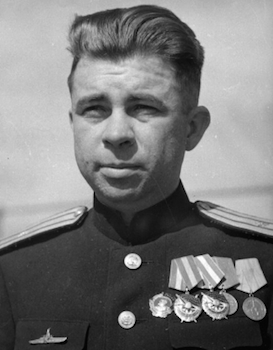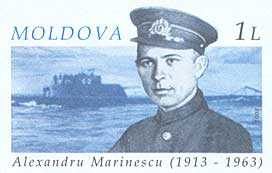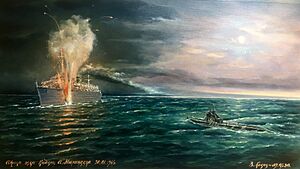Alexander Marinesko facts for kids
Quick facts for kids
Alexander Marinesko
|
|
|---|---|
 |
|
| Born | 15 January [O.S. 2 January] 1913 Odessa, Russian Empire |
| Died | 25 November 1963 (aged 50) Leningrad, Soviet Union |
| Allegiance | |
| Service/ |
|
| Years of service | 1933 – 1945 |
| Rank | Captain 3rd rank |
| Awards | Hero of the Soviet Union |
Alexander Ivanovich Marinesko (Russian: Александр Иванович Маринеско; January 15, 1913 – November 25, 1963) was a brave Soviet naval officer. During the last year of World War II, he became known as the captain of the submarine S-13. In January 1945, his submarine sank the German transport ship Wilhelm Gustloff in the Baltic Sea. This ship was carrying many people, including civilians, women, and children, who were being evacuated. More than 9,300 of the over 10,000 people on board died.
Marinesko became the most successful Soviet submarine commander. He sank ships totaling 42,000 GRT (a measure of ship size). However, at the time, the government did not think he was suitable for the highest award. In 1990, after his death, he was finally given the title Hero of the Soviet Union by President Mikhail Gorbachev.
Contents
Alexander Marinesko was born in Odessa. His father, Ion Marinescu, was a sailor from Romania. His mother, Tatiana Mihailovna Koval, was from Ukraine. His father had moved to the Russian Empire and changed his name to Ivan Marinesko.
As a young man, Alexander trained to be a sailor. He joined the Soviet Merchant Navy and later the Soviet Navy's Black Sea Fleet. He was then assigned to the Baltic Fleet. In March 1936, he became a lieutenant. By November 1938, he was a senior lieutenant.
In 1939, he became the commander of a new submarine called M-96. When it started service in 1940, it was considered the best submarine in the Baltic Fleet. Marinesko received a golden watch and was promoted to captain-lieutenant, a naval rank similar to Lieutenant Commander.
World War II Service
In June 1941, Nazi Germany attacked the Soviet Union. The M-96 submarine was supposed to move to the Caspian Sea for training. But this plan could not happen because the Germans had blocked Leningrad. On February 12, 1942, a German artillery shell hit M-96, causing a lot of damage.
In early 1943, Marinesko became the commander of the modernized submarine S-13. This submarine was one of 13 similar units, but it was the only one that survived the entire war.
Sinking of the Wilhelm Gustloff and Steuben
Marinesko and his submarine S-13 left the Soviet Porkkala Naval Base in Finland on January 11, 1945. They took a position near Kolberg by January 13. Over the next few days, German torpedo boats attacked his submarine several times.
On January 30, 1945, S-13 attacked and sank the Wilhelm Gustloff. This ship was evacuating many civilians, including families with children, and military personnel from East Prussia. It is believed that about 9,400 people died in this sinking.
A few days later, on February 10, Marinesko sank a second German ship. This was the Steuben. It was carrying mostly wounded military personnel and over 800 civilians. They were also being evacuated from East Prussia. The total number of people who died from this sinking is estimated at 4,267. These actions made Marinesko the most successful Soviet submarine commander in terms of the total size of ships he sank.
Before sinking the Wilhelm Gustloff, Alexander Marinesko had faced some serious trouble due to his discipline. Even with his successful sinkings, he was not seen as a "hero" by everyone. He was instead given the Order of the Red Banner. In October 1945, after the war ended, he was lowered in rank and discharged from the navy.
In 1960, Marinesko was given back his rank of captain third class and a full pension. In 1963, he finally received a special ceremony. This ceremony is traditionally given to a captain returning successfully from a mission, which he had not received in 1945. He died from cancer three weeks later, on November 25, 1963. He was buried at the Bogoslovskoe Cemetery in St. Petersburg. In 1990, after a newspaper helped clear his name, President Mikhail Gorbachev awarded Marinesko the title Hero of the Soviet Union after his death.
Legacy

- In 1990, a street in St. Petersburg was renamed Ulitsa Marinesko in his honor.
- The Museum of Russian Submarine Forces in St. Petersburg is named after him.
- Monuments dedicated to him have been built in Kaliningrad, Kronstadt, and Odessa.
- Marinesko is an important character in the novel Crabwalk (2002) by Günter Grass. This book describes the sinking of the Wilhelm Gustloff in detail.
Honours and awards
- Hero of the Soviet Union, 1990
- Two Orders of Lenin
- Two Orders of the Red Banner
- Medal "For Military Merit"
- Medal "For the Defence of Leningrad"
- Medal "For the Victory over Germany in the Great Patriotic War 1941–1945"
- Medal "In Commemoration of the 250th Anniversary of Leningrad", 1957


